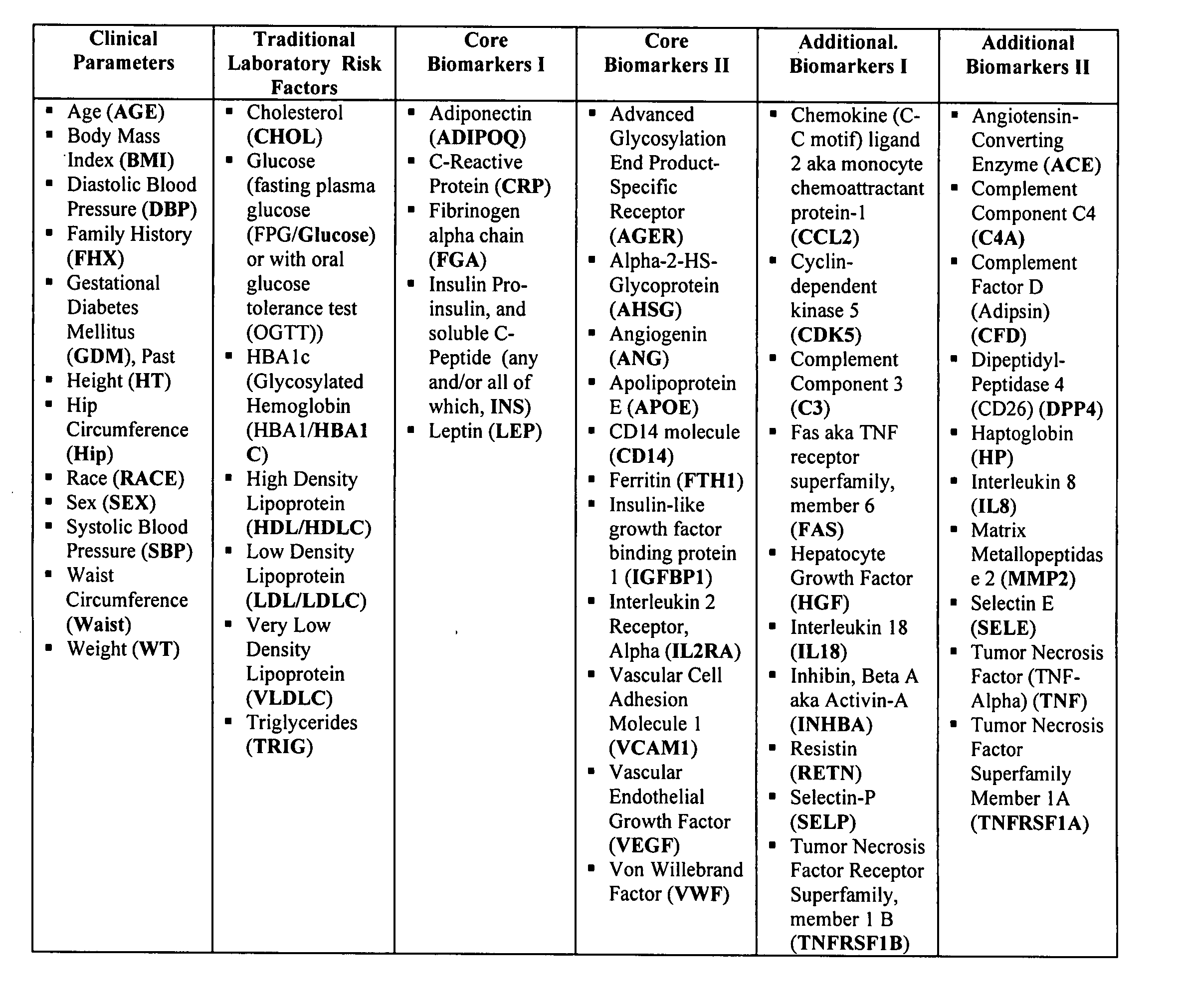Diabetes-associated markers and methods of use thereof
a technology of diabetes-associated markers and methods, applied in the field of identification of biological markers, can solve the problems of increased risk of cardiovascular, peripheral vascular and cerebrovascular diseases, diabetes, and coma for people with diabetes, and achieve the effects of improving the risk of cardiovascular disease, reducing the risk of coma, and improving the risk of cancer
- Summary
- Abstract
- Description
- Claims
- Application Information
AI Technical Summary
Benefits of technology
Problems solved by technology
Method used
Image
Examples
example 1
[0183] Example 1 presents the practice of the invention in a risk matched (age, sex, BMI, among others) case-control study design. Subjects which converted to Diabetes were initially selected and risk matched based on baseline characteristic with subjects who did not convert to Diabetes, drawing from a larger longitudinal general population study. For purposes of formula discovery, subjects were selected from the larger study with the following characteristics: [0184] Converters (C): conversion to Diabetes must have been within 5 years [0185] Non-Converters (NC): must have had at least 8 years of follow-up with no documentation of conversion to Diabetes.
[0186] Both the “Total Population” of all such subjects and a selected “Base Population” sub-population were analyzed. The Base Population was comprised of all subjects within the Total Population who additionally met the inclusion criteria of AGE equal to or greater than 39 years and BMI equal to or greater than 25 kg / m2.
[0187] De...
example 2
[0205] Example 2 demonstrates the practice of the invention in a separate general longitudinal population-based study, with a comparably selected Base sub-population and a frank Diabetes sub-analysis.
[0206] As in Example 1, for purposes of model discovery, subjects were selected from the sample sets with the following characteristics: [0207] Converters (C): conversion to Diabetes must have been within 5 years [0208] Non-Converters (NC): must have had at least 8 years of follow-up with no documentation of Diabetes.
[0209] As in Example 1, both the “Total Population” of all such subjects and a selected “Base Population” sub-population were analyzed. The Base Population was comprised of all subjects within the Total Population who additionally met the inclusion criteria of AGE equal to or greater than 39 years and BMI equal to or greater than 25 kg / m2.
[0210] Descriptive statistics summarizing each of the Example 2 study population arms are presented below in Table 5.
TABLE 5Baseline...
example 3
[0214] Example 3 is a study of the differences and similiarities between the results obtained in the two previous Examples.
[0215]FIG. 15 is a tabular representation of all parameters tested in Example 1 and Example 2, according to the T2DMARKER biomarker categories disclosed herein.
[0216] Tables summarizing T2DMARKER biomarker selection under various scenarios of classification model types and base and total populations of Examples 1 and 2 are shown in FIGS. 16A and 16B, respectively.
[0217]FIG. 17 further summarizes the complete enumeration of fitted LDA models for all potential univariate, bivariate, and trivariate combinations as measured and calculated for both Total and Base Populations of Examples 1 and 2, and encompassing all 53 and 49 T2DMARKER parameters recorded, respectively, for each study as potential model parameters. A graphical representation of the data presented in FIG. 17 is shown in FIG. 18, which shows the number and percentage of the total univariate, bivaria...
PUM
| Property | Measurement | Unit |
|---|---|---|
| concentration | aaaaa | aaaaa |
| concentration | aaaaa | aaaaa |
| concentration | aaaaa | aaaaa |
Abstract
Description
Claims
Application Information
 Login to View More
Login to View More - R&D
- Intellectual Property
- Life Sciences
- Materials
- Tech Scout
- Unparalleled Data Quality
- Higher Quality Content
- 60% Fewer Hallucinations
Browse by: Latest US Patents, China's latest patents, Technical Efficacy Thesaurus, Application Domain, Technology Topic, Popular Technical Reports.
© 2025 PatSnap. All rights reserved.Legal|Privacy policy|Modern Slavery Act Transparency Statement|Sitemap|About US| Contact US: help@patsnap.com



